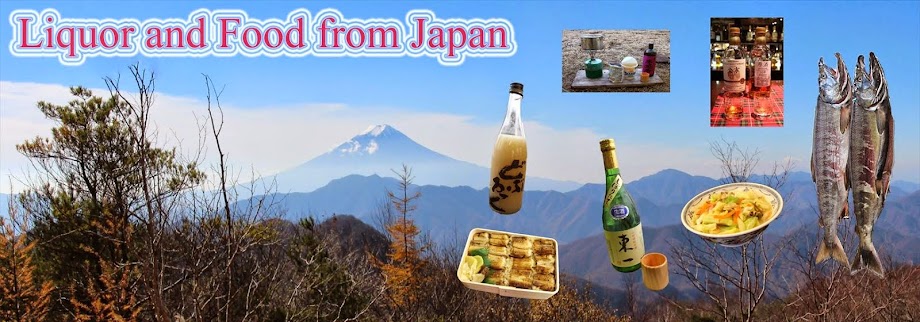In Tokyo, a rainy day continues and is humid, unpleasant atmosphere.
By the result, I was obliged to cancel the mountain climbing that I planned this weekend.
But I think that probably I am on the mountain if update of the blog is stopped.
An interval of the update may prolong because I'm going to go for some trips and mountain climbing after July.
However, I intend to obtain some gain for this blog because I have the policy which takes liquor when I climb the mountain.
By the way, I introduce "Kazenomori, Omachi, Junmai-Shiborihana" this time. This liquor is the very favorite Sake which I drink particularly frequently.
 |
| "Kazenomori, Omachi, Junmai-Shiborihana". Kazenomori has various kinds, and this is one of those. |
The rice which was generally made for the Sake of high quality is used in Yucho-Brewery making this Sake, and there is the Sake made with the normal rice which was made to eat. About the thing which "The rice for brewing Sake" made for the Sake was used for, the price is more modest than other brands.
For example, "Rice polishing rate" of this Sake is 80%. In this way, it is inexpensive, and they make it by reducing quantity that they polish it and cut down on. However, a reasonable technique is necessary to make the delicious Sake with the so difficult manufacturing method.
By the way, according to Brewery, "Shiborihana" means "The part which came out naturally without being compressed".
Outline
Yucho-Brewery making Kazenomori is in Gose-city (御所), Nara. There is the brewery in the central city area of Gose. Even if there are many knowing people, Nara is an ancient city on behalf of Japan ranking with Kyoto.Speaking of an ancient city, we are apt to imagine the old cityscape of a small range, but this Nara is sprinkled with an old temple, a Shinto shrine, cityscape over a wide area.
A model of the town was already formed in the fifth century as a stronghold of Katsuragi-family which had governed this ground. Some hills thought to be the old burial mound of the time are left in the city.
In the first place Nara is prefecture with much Sake which is delicious and indivifual. How about drinking the Japanese traditional Sake in an occasion of the sightseeing of Nara? They will surely give fun on your trip.
Character
Name: "Kazenomori, Omachi, Junmai-Shiborihana" (風の森、雄町、純米しぼり華)Place: Yucho-Brewery (油長酒造), Gose, Nara prefecture
Class: Junmai
Rice: Omachi (雄町)
Rice polishing rate: 80%
Yeast: The Society No.7 (協会7号)
Filtration: No
Heat treatment: No
Water addition: No
Alcohol content: 17%
Sake meter: -4
Acid meter: 2.0
Price: JPY 2,700 (1,800 ml)
Official website: http://www.yucho-sake.jp/Site/TOP.html
My rating: AA
Taste
The fragrance was the ethyl acetate smell that there was a few it found in low temperature in the Sake which was made to ferment for a long time frequently. Therefore the juicy sweetness characterizing Omachi which was used rice appeared. They played exquisite harmony while competing.In Kazenomori, the characteristic includes a point to include carbonic acid in richness. As Kassei-shu, it was felt so fizzy that I took a sip.
Serious sweetness melted smoothly into my tongue when it stoled out of a wave of the carbonic acid. It was taste such as the sweet carbonate juice which even a child seemed to be able to drink if it didn't include even alcohol.
Therefore slight acidity that existed from a beginning fixed the great sweetness, and the sweetness did not give heaviness to me. Though it was the Sake which only this was sweet, and was individual, it wondered at me there was a refreshing feel unexpectedly and drank it at all, and not to get tired.
The taste of this Sake thinks that the affinity of a dark dish of the taste is good because it is thick. I ate with tacos for trial, but was a good pair.
 |
| These are very mysterious combinations of Mexican food and Japanese liquor, but affinity is unexpectedly good. |
My story
As I wrote it first, Kazenomori is one of the brands which I drink frequently. It is easy to buy even a bar psychologically because one phase is lower than other Sake. It is "Kazenomori, α-type No.1" to be especially inexpensive in them. The price of Sake which I usually drink has many things about 3,000 yen with a bottle of the capacity of 1,800 ml. However, the price of this Sake is around 2,200 yen! "Alcohol content" is modest by just that much with 14%, but taste is very thick and is balanced. |
| "Kazenomori, α-type No.1". This is a experimental Sake to understand it from the name. |
I am the one who became the captive, and there is oneself of the present Kazenomori fan simply because I drank this.
By the way, I've been to near Yucho-Brewery. However, I've passed by it then without knowing the charm of the Sake because then I was the teenager who couldn't drink liquor by a law. I want to visit it by all means in Brewery if there is an opportunity to go on the next time.
How to buy (or drink)
It is inexpensive, delicious Kazenomori, but there is little amount of production, and there are a few stores in Tokyo. However, You can buy it in Uemo-Shop (google maps) of Nerima in Tokyo. It began to become popular, and it increased earlier recently to be sold out than old days.With the rise of popularity, the bars which stocked them increased considerably. When you want to drink them, please search it with the word "風の森" in the following sites.
http://tabelog.com/

































